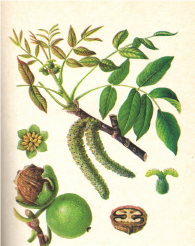Family Juglandaceae
Large trees with imparipinnate leaves. Flowers are unisexual, inconspicuous, with a simple perianth. Members of this family are rich in tannins, which accumulate in the bark, wood, leaves, and fruits. A characteristic feature is the presence of the bactericidal compound juglone, a derivative of naphthoquinone, which is not found in other families. They also contain flavonoids and pigments. Some species are rich in vitamin C and carotene. Essential oil is present in trace amounts. Seeds are very rich in fatty oil. Alkaloids have not been found, but calcium oxalate often occurs as druses.
The family includes two genera: Juglans (walnut) and Pterocarya (wingnut). The wingnut is a tree found in the Caucasus.

Leaves are very large, imparipinnate, with 2–3–5 pairs of leaflets; the upper impar leaflet is larger than the lateral ones; leaflets are oblong-ovate, with entire margins and glabrous surfaces. Staminate flowers are grouped in large catkins; pistillate flowers appear in clusters of 2–3. The fruit is a drupe, oval or spherical, with a green, leathery, fleshy exocarp and a woody endocarp (stone). When ripe, the exocarp splits and separates, while the stone with the seed inside is called a walnut. It blooms in April–May during leaf budding; fruits ripen in August–September.
Wild walnut groves exist in the mountains of Central Asia. In the Caucasus, wild or feral walnuts can be found. It is widely cultivated in southern regions.
Walnut leaves, Folium Juglandis, are harvested in June when they are not yet fully developed, covered in essential oil glands, and still have a balsamic fragrance. The leaflets are stripped from the central petiole. The leaves are used fresh because slow drying causes them to blacken.
The carotene content in the leaves is very high, exceeding 30 mg%, and the vitamin C content ranges from 285 to 1300 mg% or more. As the leaves develop, their ascorbic acid content gradually increases, peaking in the middle of the vegetative period when the fruits are still unripe. Vitamins P and B have also been found, along with traces of essential oil, tannins (3–5%), ellagic and gallic acids, and the pigment juglone, which is 5-hydroxy-1,4-a-naphthoquinone with bactericidal and fungistatic properties. Additionally, it contains flavonoids like quercetin and kaempferol, and caffeic acid.
